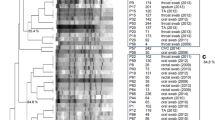Abstract
During a study of oral rinses of 130 HIV-infected individuals, both typical and atypicalCandida albicans colonies were isolated from ten patients on a yeast differential medium. TypicalCandida albicans colonies were light green; atypical colonies were dark green. Both types of colonies were germ tube-positive and produced chlamydospores. However, DNA fingerprinting of the atypical isolates with the Ca3Candida albicans-specific probe showed that they belonged to the recently described speciesCandida dubliniensis.Candida dubliniensis colonies could also be differentiated fromCandida albicans colonies on isolation plates by the absence of fluorescence of colonies on methyl blue-Sabouraud agar under Wood's light. Among other phenotypic characteristics, only the absence of intracellular β-glucosidase activity reliably distinguishedCandida albicans fromCandida dubliniensis.Candida dubliniensis may be underreported in clinical samples because most currently used isolation and identification methods fail to recognize this yeast.
Similar content being viewed by others
References
Feigal DW, Katz MH, Greenspan D, Westenhouse J, Winkelstein W, Lang W, Samuel M, Buchbinder SP, Hessol NA, Lifson AR, Rutherford GW, Moss A, Osmond D, Shiboski S, Greenspan JS: The prevalence of oral lesions in HIV-infected homosexual and bisexual men: three San Francisco epidemiological cohorts. AIDS 1991, 5: 519–525.
Stevens DA: Fungal infections in AIDS patients. British Journal of Clinical Practice 1990, 44, Supplement 71: 11–22.
Powderly WG: Mucosal candidiasis caused by nonalbicans species ofCandida in HIV-positive patients. AIDS 1992, 6: 604–605.
Warnock DW: Azole drug resistance inCandida species. Journal of Medical Microbiology 1992, 37: 225–226.
Boerlin P, Boerlin-Petzold F, Durussel C, Addo M, Pagani J, Chave J, Bille J: Cluster of oral atypicalCandida albicans isolates in a group of human immunodeficiency virus-positive drug users. Journal of Clinical Microbiology 1995, 33: 1129–1135.
McCullough M, Ross B, Reade P: Characterization of genetically distinct subgroup ofCandida albicans strains isolated from oral cavities of patients infected with human immunodeficiency virus. Journal of Clinical Microbiology 1995, 33: 696–700.
Schmid J, Odds FC, Wiselka MJ, Nicholson KG, Soll DR: Genetic similarity and maintenance ofCandida albicans strains from a group of AIDS patients, demonstrated by DNA fingerprinting. Journal of Clinical Microbiology 1992, 30: 935–941.
Sullivan D, Bennett D, Henman M, Harwood P, Flint S, Mulcahy F, Shanley D, Coleman D: Oligonucleotide fingerprinting of isolates ofCandida species other thanCandida albicans and of atypicalCandida species from human immunodeficiency virus-positive and AIDS patients. Journal of Clinical Microbiology 1993, 31: 2124–2133.
Sullivan DJ, Westerneng TJ, Haynes KA, Bennett DE, Coleman DC:Candida dubliniensis sp. nov.: phenotypic and molecular characterization of a novel species associated with oral candidosis in HIV-infected individuals. Microbiology 1995, 141: 1507–1521.
Odds FC, Bernaerts R: CHROMagar Candida, a new differential isolation medium for presumptive identification of clinically importantCandida species. Journal of Clinical Microbiology 1994, 32: 1923–1929.
Goldschmidt Millicent C, Fung DYC, Grant R, White J, Brown T: New aniline blue dye medium for rapid identification and isolation ofCandida albicans. Journal of Clinical Microbiology 1991, 29: 1095–1099.
Scherer S, Stevens DA: ACandida albicans dispersed, repeated gene family and its epidemiologic applications. Proceedings of the National Academy of Sciences of the USA 1988, 85: 1452–1456.
Schmid J, Voss E, Soll DR: Computer assisted methods for assessing strain relatedness inCandida albicans by fingerprinting with the moderately repetitive sequence Ca3. Journal of Clinical Microbiology 1990, 28: 1236–1243.
Soll DR, Langtimm CJ, Mcdowell J, Hicks J, Galask R: High frequency switching inCandida strains isolated from vaginitis patients. Journal of Clinical Microbiology 1987, 25: 1611–1622.
Soll DR, Staebell M, Langtimm C, Pfaller M, Hicks J, Rao G: MultipleCandida strains in the course of a single systemic infection. Journal of Clinical Microbiology 1988, 26: 1448–1459.
Engler-Blum. G, MeierM, Frank J, Müller GA: Reduction of background problems in nonradioactive northern and southern blot analyses enables higher sensitivity than 32P-based hybridizations. Analytical Biochemistry 1993, 210: 235–244.
Author information
Authors and Affiliations
Rights and permissions
About this article
Cite this article
Schoofs, A., Odds, F.C., Colebunders, R. et al. Use of specialised isolation media for recognition and identification ofCandida dubliniensis isolates from HIV-infected patients. Eur. J. Clin. Microbiol. Infect. Dis. 16, 296–300 (1997). https://doi.org/10.1007/BF01695634
Issue Date:
DOI: https://doi.org/10.1007/BF01695634




